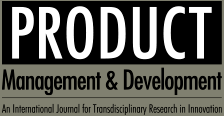Benefits of the empathy map method and the satisfaction of a company with its application in the development of concepts for a white glue tube
Carina Campese, Camila Alejandra Leon Vanegas, Janaina Mascarenhas Hornos da Costa
Abstract
User-centered design (UCD) can be understood as a philosophy, a process, or even an approach, that has the objective to increase the consideration of user needs in the design process. In particular, an empathy map is a UCD method that seeks the definition of a user profile and user needs. Because the method is gaining importance in the literature and in applications to perform services and design products, we report on an application of the empathy map method and evaluate its usefulness. The empathy map was applied by 25 trainees in a controlled experiment in the concept phase for a white glue tube design process, in a partnership with a company that produces office supplies. The method helped in many aspects, mainly in organizing the information collected and understanding the user. Both the students and the company were satisfied with the results that the method provided.
Keywords
References
ABRAS, C.; MALONEY-KRICHMAR, D.; PREECE, J. User-centered design. In: BAINBRIDGE, W. Encyclopedia of human-computer interaction. Thousand Oaks: Sage Publications. p. 445-456, 2004. v. 37. n. 4.
BAGNALL, P.; DEWSBURY, G.; SOMMERVILLE, I. The limits of personas. In: 5th ANNUAL DIRC CONFERENCE, 5., 2005, Edinburgh. Proceedings… Edinburgh, 2005. p. 38-39.
BERTHOLDO, A. P. O. et al. Agile usability patterns for UCD early stages. In: MARCUS, A. (Eds.). Design, user experience, and usability: theories, methods, and tools for designing the user experience. Cham: Springer International Publishing, 2014. p. 33-44.
BRATSBERG, H. M. Empathy maps of the foursight preferences. New York: International Center for Studies in Creativity, 2012.
CHANG, Y.; LIM, Y.; STOLTERMAN, E. Personas: from theory to practices. In: NORDICHI ’08 – 5th NORDIC CONFERENCE ON HUMAN-COMPUTER INTERACTION: BUILDING BRIDGES, 5., 2008, Lund, Sweden. Proceedings… New York: ACM Press, 2008. p. 439-442.
CHAPMAN, C. N.; MILHAM, R. P. The personas’ new clothes: methodological and practical arguments against a popular method. Proceedings of the Human Factors and Ergonomics Society Annual Meeting, v. 50, n. 5, p. 634-636, 2006.
CHEN, K.; CHOU, W. Emotional experience and interactive design in the workplace. In: MARCUS, A. (Eds.). International conference of design, user experience, and usability. Berlin: Springer, 2013. p. 446-454.
COOPER, A. et al. About face: the essentials of interaction design. 4th ed. John Wiley & Sons Inc., 2014.
COOPER, A. The inmates are running the asylum. Hoboken: Sams Publishing, 1999.
GRUDIN, J.; PRUITT, J. Personas, participatory design and product development: an infrastructure for engagement. In: PARTICIPATORY DESIGN CONFERENCE, 2., 2002, Sweden. Proceedings... New York: ACM Press, 2002. p. 23-25.
HJALMARSSON, A. Exploring the use of personas in user-centered design of web-based e-services. In: ICONFERENCE, 2015, Newport Beach. Proceedings... California, 2015. p. 1-15.
JURCA, G.; HELLMANN, T. D.; MAURER, F. Integrating agile and user-centered design: a systematic mapping and review of evaluation and validation studies of agileUX. In: AGILE CONFERENCE, 14., 2014, Washington. Proceedings... Washington: IEEE Computer Society, 2014. p. 24-32.
KOUPRIE, M.; VISSER, F. S. A framework for empathy in design: Stepping into and out of the user’s life. Journal of Engineering Design, v. 20, n. 5, p. 437-448, 2009.
LEONARD, D.; RAYPORT, J. F. Spark innovation through empathic design. Harvard Business Review, v. 75, p. 102-115, jan. 1997.
MAGUIRE, M. Methods to support human-centred design. International Journal of Human-Computer Studies, v. 55, n. 4, p. 587-634, 2001.
MAO, J.; VREDENBURG, K. User-centered design methods in practice: a survey of the state of the Art Paul W Smith. In: CONFERENCE OF THE CENTRE FOR ADVANCED STUDIES ON COLLABORATIVE RESEARCH, 01., 2000, Toronto. Proceedings... Toronto: IBM Press, 2000. p. 12-12.
MIASKIEWICZ, T.; KOZAR, K. A. Personas and usercentered design: how can personas benefit product design processes? Design Studies, v. 32, n. 5, p. 417-430, 2011.
MÜLLER, M. Management by empathy learning with experience design. In: M/O/T INTERNATIONAL CONFERENCE ON MANAGEMENT LEARNING, 2010, Viena. Proceedings... Klagenfurt: M/O/T School of Management, 2010. p. 1-25.
NORMAN, D. The design of everyday things. New York: Basic Books, 2013.
OSTERWALDER, A.; PIGNEUR, Y. Business model generation. New Jersey: John Wiley & Sons Inc., 2010.
PLATTNER, H. Bootcamp bootleg. Stanford: Institute of Design, 2010.
PRESSMAN, R. S. Software engineering – A practitioner’s approach. 7th ed. New York: McGraw-Hill, 2010.
RIPPON, S. Usability, user-centered design (UCD) and FOSS. In: OPEN SOURCE DEVELOPERS’ CONFERENCE, 2006, Melbourne. Proceedings... Melbourne: OSDC, 2006.
SHADISH, W. R.; COOK, T. D.; CAMPBELL, D. T. Experiments and generalized causal inference. In: HOUGHTON, M.(Ed.). Experimental and quasiexperimental designs for generalized causal inference. 2nd ed. New York: Houghton Mifflin Compan, 2002. p. 1-32.
SILVA, T. S. et al. User-centered design and agile methods: a systematic review. In: AGILE CONFERENCE, 2011, Washington. Proceedings... Washington: IEEE Computer Society, 2011. p. 77-86.
SYMONDS, B. Y. P. M. On the loss of reliability in ratings due to coarseness of the scale. Journal of Experimental Psychology, v. 7, n. 6, p. 456-461, 1924.
VAN KUIJK, J.; VAN DRIEL, L.; VAN EIJK, D. Usability in product development practice; an exploratory case study comparing four markets. Applied Ergonomics, v. 47, 2015.
VIANNA, M. et al. Design thinking: inovação em negócios. Rio de Janeiro: MJV Press, 2012.

